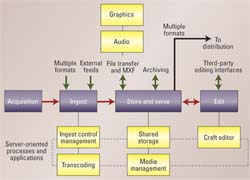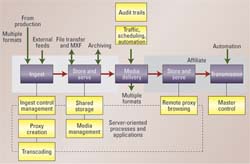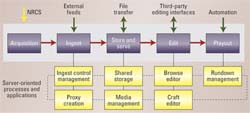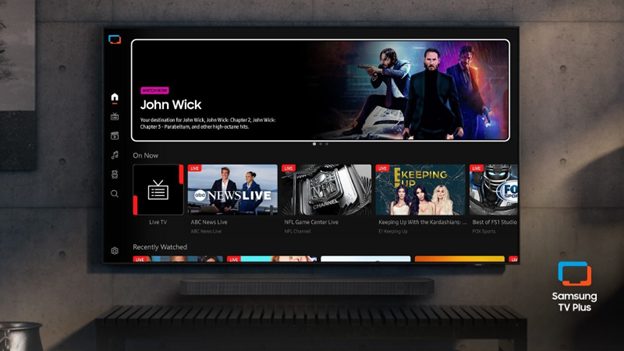Selecting a workflow-oriented server
Selecting a video server requires careful plan ning and research. A server is a critical infrastructure product, and a station’s choice of servers must make both short-term and long-term sense.
Step one in any server-purchase decision is to define the specific application. What does the server need to do? For example, an on-air playback server is quite different from a clip playback server for a production application, both in terms of capability/performance and cost. Step two is to understand who the key players are in terms of providing solutions. Armed with both need (what the server must do) and solution (vendors), the technical manager or engineer is equipped to begin the decision-making process. It’s not an easy task; the industry is constantly in transition.
The application-specific server, designed to support a single function such as transmission or commercial insertion, is a common element in almost every facility. Over the last few years, the progression from cart machines to single-function servers has been logical and necessary. But, because of continuing pressure to accomplish more with less, broadcasters are now moving away from that model toward server platforms that can support multiple applications.
For optimum efficiency, server design must address an entire workflow, not just a single function or even a set of unassociated applications. At most facilities, there are multiple workflows in play, each with a set of associated functions. Thus, the formula for selecting a workflow-oriented server is not simple. But there are ways to improve the decision-making process.
Compelling reasons
With today’s strict budgets, stations have to make the most of diminishing resources, be they hardware, human or financial. Thus, the reasons to consider a workflow-oriented server rather than an application-specific one are compelling. Broadcasters can improve productivity, reduce costs and maximize resources by analyzing a workflow, breaking it down into the various applications involved and then identifying a server that can support (and enhance) that workflow.
With a news or distribution workflow, for example, a station must identify the primary and secondary applications required, and the I/O and the points of interchange. These criteria must then be incorporated into whichever server architecture provides the best fit for current and future operations. If the station performs this research correctly, it can create an infrastructure that solves a comprehensive set of workflow requirements while addressing issues such as legacy equipment and the company’s target path of migration.
The professional video industry's #1 source for news, trends and product and tech information. Sign up below.
By their very nature, shared-storage servers have already simplified station routing by delivering content to specified destinations within a storage-area network (SAN). A server-centric architecture enables specific applications to access a common set of media. The associated metadata can reflect the state of the media within the application chain for increased operational efficiency. The advantages are clear, in terms of workflow, content availability and the ease with which tasks can be accomplished (with fewer resources).
Workflow analysis
The first step in simplifying workflow and reducing cost is a detailed workflow analysis. Many stations have accomplished this already, but not necessarily with servers in mind. It is a good idea to seek assistance from a contractor or workflow consultant, but it is important to also seek the guidance of someone in house.
The chief engineer, news director, program director or a team of in-house experts should map out each phase of every workflow under consideration. Start with large functional blocks and progress to whatever level of detail is necessary, identifying each I/O, required format and point of interface. Look for areas that will benefit from the streamlining and simplification offered by common storage-oriented software applications. Look for paths where file-based media interchange offers advantages over traditional interconnection. Be receptive to changing the staff’s skill sets to be in sync with new methods of working. Clarify the areas that will need customization. And, yes, identify each point of complexity or potential trouble.
Those intimately involved in a facility’s day-to-day operations must guide the analysis. They know how current operations are performed, why the system was built the way it was and where the trapdoors are hidden.
Research the manufacturers
Once the team has a clear idea of the workflows to address and the components and applications within each workflow, the next step is research. Establish what each vendor has to offer. Research their server hardware and their software thoroughly, realizing that there will be caveats. Products are in flux, solutions are in flux, and that truth is not going to change any time soon.
Knowing that the solutions will change, particularly applications and interfaces, plan in advance what is realistic and what isn’t in today’s environment. Research a manufacturer’s available documentation and APIs, as well as how it interacts with other (potentially competing) manufacturers. Your station will be better off working with one that provides a well-documented architecture with defined, sensible APIs and standard protocols.
Vendor presentation and analysis
At this point, armed with in-depth research, invite workflow-specific presentations by key manufacturers and system integrators. Present them with current workflows and requirements for streamlined server-based workflows. Providing these specifics will enable each vendor to hone a solution.
Keep an open mind during these presentations — vendors may present alternate methodologies that you hadn’t considered before. Compare different vendors’ solutions, and determine how they would impact the facility’s requirements. Realize that no quantity of a single manufacturer’s off-the-shelf equipment will exactly solve all workflow problems. Finding the right server-oriented workflow will inevitably require some degree of intervendor compatibility and customization.
The ideal manufacturer will provide a well-documented architecture that lends itself to third-party applications as well as to customization by the client or the system integrator. Considerations may include legacy interfaces or the proper API hooks to customize the master control UI. In any case, for greater success, consult with an engineer or programmer who understands the workflow and the interfaces and is handy with an API or protocol.
Perhaps most important, beware vendors who gloss over a point or say “That’s easy,” or “Don’t worry, it will.”
Production-workflow server

Figure 1. In this production workflow, multiple formats can be ingested, stored and shared among the various server- oriented applications. Click here to see an enlarged diagram.
Figure 1 shows a typical production workflow. The first consideration when choosing a server for a production workflow is its ability to handle multiple formats. Production houses are beginning to use multiple formats. Broadcasters need to be more open as time goes on, particularly when new multiformat cameras (producing SD, HD, compressed video and proxy video) become more widely used.
Manufacturers designing new acquisition and production devices are including workflow tools from inception, so it stands to reason that a broadcaster’s choice of servers should mirror that principle. This, in turn, requires multiformat flexibility on the server’s ingest side and a targeted set of formats on the output side. Hand-in-hand with format flexibility, consider the ease (and the cost) of adding a new format or transcoding process to the server. Migration capacity must be built in.
Additional production-workflow considerations include the server’s a bility to interface to editing applications, graphics and audio applica-tions, and the ability to process Material eXchange Format (MXF), Advanced Authoring Format (AAF) and metadata. These emerging inter-change technologies will make it easier for a facility to transport media between various vendors’ systems. They will also increase interoperability in servers for multiple workflows (such as production and news).
The importance of metadata cannot be overlooked when considering a production-oriented server. Beyond the basic advantages of query and search capability, the production server should have built-in capacity to store, parse and manipulate metadata. A server that intelligently incorporates metadata not only has knowledge of all stored media, but also the ability to track the state of the media within a given workflow and communicate this information to other processes.
Distribution-workflow server

Figure 2. In addition to multiformat ingest and playout, this distribution workflow highlights the affiliate’s ability to browse and pull content remotely. Click here to see an enlarged diagram.
Figure 2 shows a typical distribution workflow. In this process, a facility ingests and stores master programming and subsequently feeds it to affiliates, cable headends and to air. Ideally, the distribution-oriented server should have flexible format capability on both ingest and playout sides, with the ability to handle long-GOP MPEG through ASI and file-interchange mechanisms such as MXF.
Connectivity is of prime importance with this workflow model. The server not only needs to deliver content in real time (baseband or ASI), it must also be able to stream files without the need for external gateways (which add cost and complexity). At the minimum, Gigabit Ethernet connectivity and FTP support must be built in. Metadata functionality and a tightly integrated proxy application are equally important, not just for in-house browse and push capability, but also to allow remote users to access the server’s content. The server’s architecture must support both models and, preferably, should have an integrated browse application.
The server’s intelligent metadata processing also facilitates any required interfaces to archive and media-asset-management (MAM) systems, and allows the station to track precisely where and when content was delivered (audit trails). Metadata can also be used to track origination and ownership and to ease digital-rights management.

Figure 3. Shared storage is the key to this news workflow. It gives all server-oriented applications instant and secure access to content. Click here to see an enlarged diagram.
News-workflow server
Figure 3 shows a typical news workflow. Of the three sample workflows discussed here, news is the most application-intensive and, by necessity, requires key components in its workflow-oriented server. Above all, it requires a shared-storage environment that enhances collaboration and integration. Because speed is essential, it’s important not to have to transfer anything. Once material has been ingested, it should be instantly available to all users for browsing, editing and, ultimately, for playout in a rundown.
Format is of lesser importance, primarily because news organizations are standardizing field formats and studio formats such as DV. Important factors are high-speed SAN (i.e., Fibre Channel) connectivity and integration of news applications within the server, such as ingest management, browsing, low-resolution proxy editing and high- resolution craft editing. (The fact that many server platforms are PCs solves the integration problem at the outset.) For long-form editing requirements, consider how well the server interfaces with third-party editing systems and the ease with which that material can be brought into shared storage.
Lastly, of all the protocols required, the server’s ability to support Media Object Server (MOS) protocol is most beneficial for streamlining communications between the newsroom computer system (NRCS) and the server.
Path of wisdom
Selecting a workflow-oriented server is a path with inherent wisdom, but one that involves detailed analysis of workflow needs and manufacturers’ offerings. The investment in a server is simply too critical to lock in a solution that is not scalable and flexible.
For the station that wants to create an infrastructure supporting legacy equipment, current requirements and a migration path, a workflow-oriented server makes good sense and provides a way to build in capacity for new formats and improved applications. The result will be a marked improvement in the efficiency of the facility.
Todd S. Roth is vice president of technology for the video server division at Leitch Technology.
